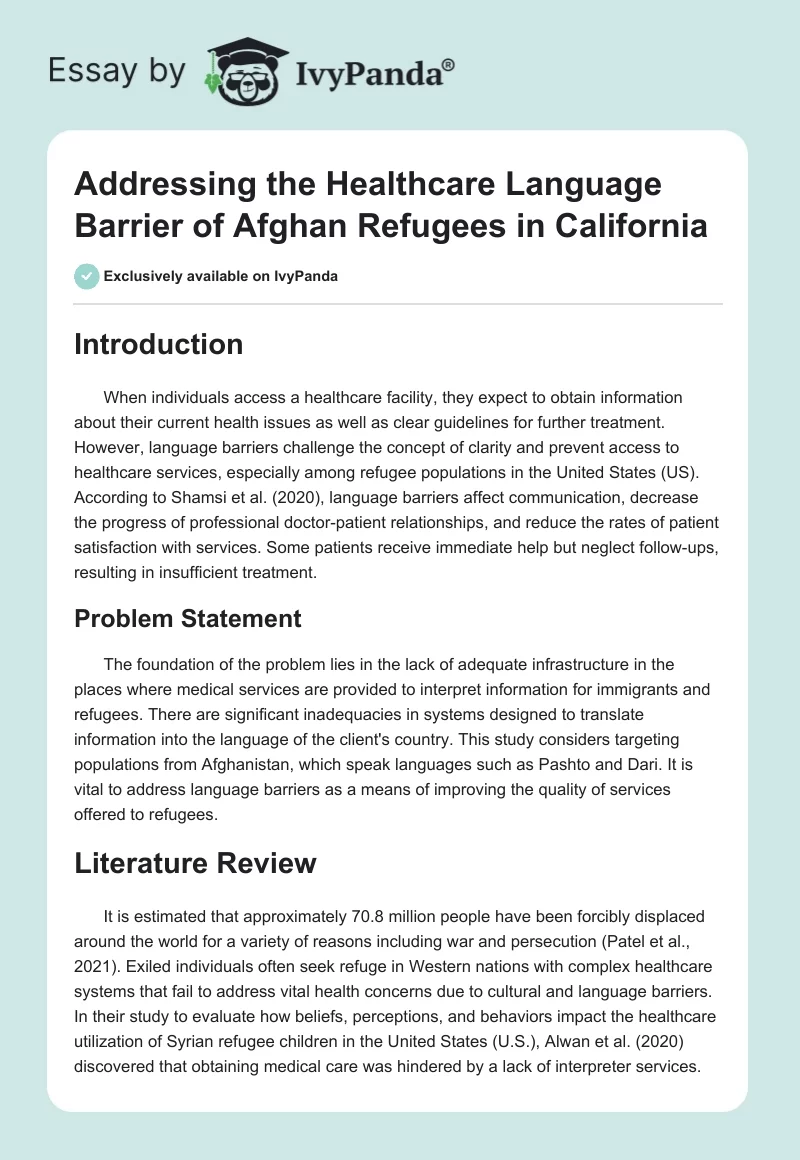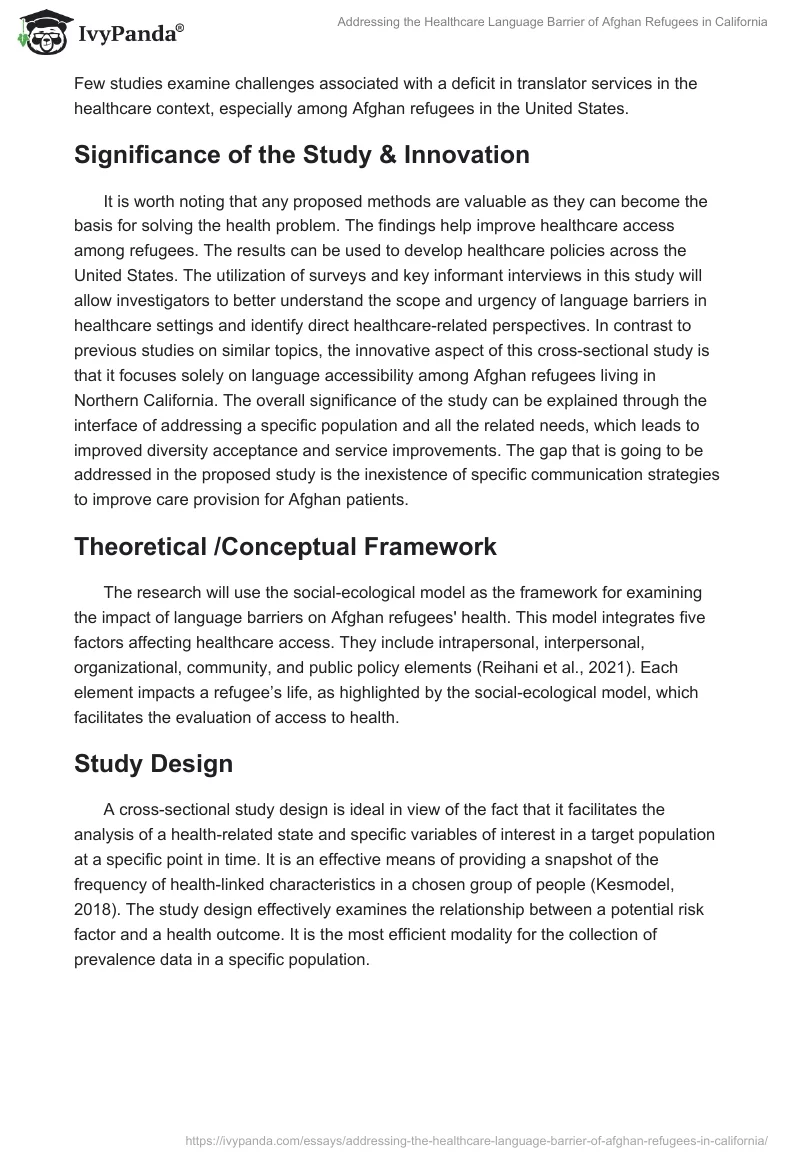Introduction
When individuals access a healthcare facility, they expect to obtain information about their current health issues as well as clear guidelines for further treatment. However, language barriers challenge the concept of clarity and prevent access to healthcare services, especially among refugee populations in the United States (US). According to Shamsi et al. (2020), language barriers affect communication, decrease the progress of professional doctor-patient relationships, and reduce the rates of patient satisfaction with services. Some patients receive immediate help but neglect follow-ups, resulting in insufficient treatment.
Problem Statement
The foundation of the problem lies in the lack of adequate infrastructure in the places where medical services are provided to interpret information for immigrants and refugees. There are significant inadequacies in systems designed to translate information into the language of the client’s country. This study considers targeting populations from Afghanistan, which speak languages such as Pashto and Dari. It is vital to address language barriers as a means of improving the quality of services offered to refugees.
Literature Review
It is estimated that approximately 70.8 million people have been forcibly displaced around the world for a variety of reasons including war and persecution (Patel et al., 2021). Exiled individuals often seek refuge in Western nations with complex healthcare systems that fail to address vital health concerns due to cultural and language barriers. In their study to evaluate how beliefs, perceptions, and behaviors impact the healthcare utilization of Syrian refugee children in the United States (U.S.), Alwan et al. (2020) discovered that obtaining medical care was hindered by a lack of interpreter services. Few studies examine challenges associated with a deficit in translator services in the healthcare context, especially among Afghan refugees in the United States.
Significance of the Study & Innovation
It is worth noting that any proposed methods are valuable as they can become the basis for solving the health problem. The findings help improve healthcare access among refugees. The results can be used to develop healthcare policies across the United States. The utilization of surveys and key informant interviews in this study will allow investigators to better understand the scope and urgency of language barriers in healthcare settings and identify direct healthcare-related perspectives. In contrast to previous studies on similar topics, the innovative aspect of this cross-sectional study is that it focuses solely on language accessibility among Afghan refugees living in Northern California. The overall significance of the study can be explained through the interface of addressing a specific population and all the related needs, which leads to improved diversity acceptance and service improvements. The gap that is going to be addressed in the proposed study is the inexistence of specific communication strategies to improve care provision for Afghan patients.
Theoretical /Conceptual Framework
The research will use the social-ecological model as the framework for examining the impact of language barriers on Afghan refugees’ health. This model integrates five factors affecting healthcare access. They include intrapersonal, interpersonal, organizational, community, and public policy elements (Reihani et al., 2021). Each element impacts a refugee’s life, as highlighted by the social-ecological model, which facilitates the evaluation of access to health.
Study Design
A cross-sectional study design is ideal in view of the fact that it facilitates the analysis of a health-related state and specific variables of interest in a target population at a specific point in time. It is an effective means of providing a snapshot of the frequency of health-linked characteristics in a chosen group of people (Kesmodel, 2018). The study design effectively examines the relationship between a potential risk factor and a health outcome. It is the most efficient modality for the collection of prevalence data in a specific population.
Methodology
A semi-structured interview approach will be adopted during the study. IRB approval will be sought from UC Santa Cruz prior to study implementation. Each of the participants will be interviewed independently for 60-90 minutes. Each of the respondents will be provided with a detailed description of the study and reassured about adherence to ethical principles such as confidentiality and anonymity. The venue for the interviews will be free from distractions, and the locations that will be chosen will be the most ideal for the participants.
Measures/Instrumentation
The questions in the semi-structured interviews are designed to evaluate the degree to which the lack of interpreters during clinic visits impacts access to healthcare among California’s Afghan population. The interviews incorporate a series of questions that help the researcher explore areas of interest, such as the impact of limited English proficiency and the lack of an interpreter on access to healthcare services in California., motivations, and perspectives. The instrument’s inherent flexibility allows participants to explore and highlight issues that the researcher may have overlooked. It also allows for the assessment of the target population’s experiences
Population and Sampling
California is the basis for this study because it is home to the highest number of Afghan refugees in the United States (U.S.). According to the Center for Immigrant Studies (CIS), approximately 133,000 foreign-born Afghans lived in the U.S. in 2019 (Camarota & Zeigler, 2021). The study will be focused on San Jose in Northern California. Individuals that will be included are Afghan refugees that are eighteen years or older and have lived in California for a minimum of three years. In addition, they must have at least one living child who resides in the same state, should have attended at least one medical appointment with a healthcare practitioner, and have low English proficiency.
Data Analysis
The researcher intends to survey 50 patients of different ages to gain a more complete insight into the problem of language barrier. It will be essential to prepare and organize the information gathered from the respondents (Campus Labs, 2020). This will involve printing the transcripts and gathering notes and other materials used in the research exercise. It is necessary to read the data several times to understand its key components while keeping notes on important ideas. The creation of initial codes using highlighters and sticky notes to form connections in the data is vital. Interview results will be coded using NVivo software. Deductive thematic analysis will be employed to identify common themes that apply to the study sample. The reliability of the data will be guaranteed by ensuring that a different analyst reviews and assesses the data to check for compatibility with the researcher’s findings.
Strengths
The study’s strengths include the fact that it focused on a state with one of the nation’s highest Afghan populations, and it included an interpreter during the interviews. In addition, the interviewer was well-versed in the Dai and Pashto languages, which facilitated the effective communication of ideas. The interview process included at least one guardian per household, as well as the children.
Limitations
The sample size is small, meaning that the determination of whether the existence of language challenges during clinical visits is a true outcome may be problematic. The second liability is that the study sample was recruited solely from a resettlement agency, which excluded individuals who came into the country through other means. There was the risk of interview bias because of preconceived ideas about Afghan refugees, recall bias due to traumatic experiences, and response bias as a result of challenges associated with adapting to a new country.
Conclusions
The Afghan community in California experiences a variety of challenges, such as limited English proficiency, low levels of education, financial instability, and limited health insurance, which impact access to healthcare services. A cross-sectional design, alongside a semi-structured interview approach, was used to analyze language barrier issues in medical settings of Afghan refugees living in Northern California.
Implications for Future Research
In the future, investigators should replicate this study in other high Afghan concentrated settings to compare results and gain additional perspective across different locations. Researchers should also consider studying the effects of large-scale optimization of implementing language line services, as well as hiring interpreters/part-time staff in healthcare settings.
References
Alwan, R. M., Schumacher, D. J., Cicek-Okay, S., Jernigan, S., Beydoun, A., Salem, T., & Vaughn, L. M. (2020). Beliefs, perceptions, and behaviors impacting healthcare utilization of Syrian refugee children. PLOS ONE, 15(8), 1–16. Web.
Camarota, S. A., & Zeigler, K. (2021). Immigrants from Afghanistan: A profile of foreign-born Afghans. In Center for Immigration Studies (Issue September). Web.
Campus Labs. (2020). How to analyze qualitative data. Web.
Kesmodel, U. S. (2018). Cross-sectional studies – what are they good for?Methodology in Clinical Epidemiological Research in Obstetrics and Gynecology, 97(4), 388–393. Web.
Patel, P., Bernays, S., Dolan, H., Muscat, D. M., Trevena, L., Mwanri, L., Gesesew, H., Fauk, N. K., & Mude, W. (2021). Communication experiences in primary healthcare with refugees and asylum seekers: A literature review and narrative synthesis. International Journal of Environmental Research and Public Health, 18(4), 1–18. Web.
Reihani, A. R., Zimmerman, H. G., Fernando, N., Saunders, D. R., Edberg, M., Carter, E., Projects Manager, S., George, P., & Director, C. (2021). Barriers and facilitators to improving access to healthcare for recently resettled Afghan refugees: A transformative qualitative study. The Italian Journal for Interdisciplinary Health and Social Development, 6, 59–72. Web.
Shamsi, H. A., Almutairi, A. G., Mashrafi, S. A., & Kalbani, T. A. (2020). Implications of language barriers for healthcare: A systematic review. Oman Medical Journal, 35(2). Web.


